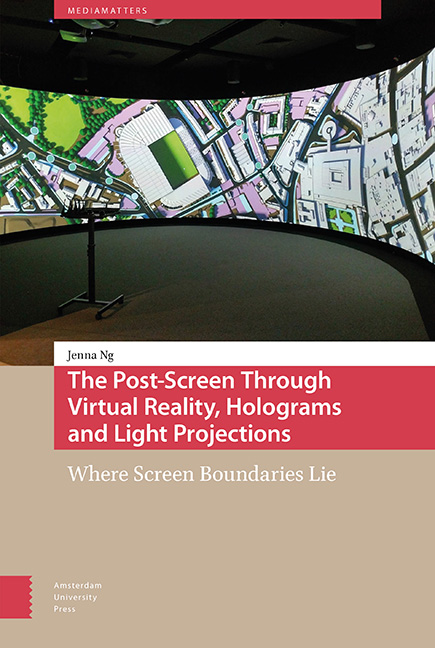 The Post-Screen through Virtual Reality, Holograms and Light Projections
The Post-Screen through Virtual Reality, Holograms and Light Projections Book contents
- Frontmatter
- Dedication
- Table of Contents
- Acknowledgements
- Introduction
- 1 Screen Boundaries as Movement
- 2 Leaking at the Edges
- 3 Virtual Reality: Confinement and Engulfment; Replacement and Re-placement
- 4 Holograms/Holographic Projections : Ghosts Amongst the Living; Ghosts of the Living
- 4A (Remix) True Holograms: A Different Kind of Screen; A Different Kind of Ghost
- 5 Light Projections: On the Matter of Light and the Lightness of Matter
- Conclusion/Coda
- Index
Introduction
- Frontmatter
- Dedication
- Table of Contents
- Acknowledgements
- Introduction
- 1 Screen Boundaries as Movement
- 2 Leaking at the Edges
- 3 Virtual Reality: Confinement and Engulfment; Replacement and Re-placement
- 4 Holograms/Holographic Projections : Ghosts Amongst the Living; Ghosts of the Living
- 4A (Remix) True Holograms: A Different Kind of Screen; A Different Kind of Ghost
- 5 Light Projections: On the Matter of Light and the Lightness of Matter
- Conclusion/Coda
- Index
Summary
Abstract
This Introduction presents the context for the book's argument of the post-screen, namely, an argument for a state of critical attention to the delimitations of screen media and the ensuing problematizations of relations between image and object; an intensifying evolution of the virtual and its role in defining media consumers and their realities; and an era of screen media marked by the disappearances of boundaries of differentiation between subject and object; and a point in media history. The central query of the post-screen lies in the growing imperceptibility and instability of screen boundaries. Where these thresholds begin to disappear is also where the need arises to re-question the definitional states of the actual and the virtual, and the renewed contestations for dominance between them.
Keywords: post-screen; boundaries; La Condition Humaine; Bazin; Baudrillard; hunger
Post-Screen Media: Meshing the Chain Mail
Screens offer a seemingly endless supply of information, but the true value of the page is not what it allows us to know, but how it allows us to be known.
∼ Jonathan Safran FoerThe frame descended at the end, capping a mysterious drama. Minutes earlier, a flash mob had appeared inside a shopping centre in Breda as an ensemble of characters in seventeenth century dress. They re-enacted various scenes: a thief clutching his spoils and fleeing with guards in hot pursuit; two military figures marching into the square at the head of a cavalry; a dwarf scurrying along while shooing the crowd; a girl picking up her skirts and running after a squawking chicken.
The performance turned out to be an ingenious publicity stunt for the 2013 re-opening of the Rijksmuseum in Amsterdam, which had closed for a decade-long renovation. For the skit's denouement, the actors assembled in the central space of the shopping centre. They settled into approximate correspondences with the postures exhibited by the characters in Rembrandt's De Nachtwatcht, thus re-creating the museum's arguably most famous painting. Once everyone was in place, the concluding touch arrived: a rectangular construction, bearing the museum's opening and sponsorship notices, descended from the ceiling and came to rest around the actors.
Information
- Type
- Chapter
- Information
- The Post-Screen through Virtual Reality, Holograms and Light ProjectionsWhere Screen Boundaries Lie, pp. 15 - 50Publisher: Amsterdam University PressPrint publication year: 2021